1993 CHEVROLET SUBURBAN change wheel
[x] Cancel search: change wheelPage 190 of 386
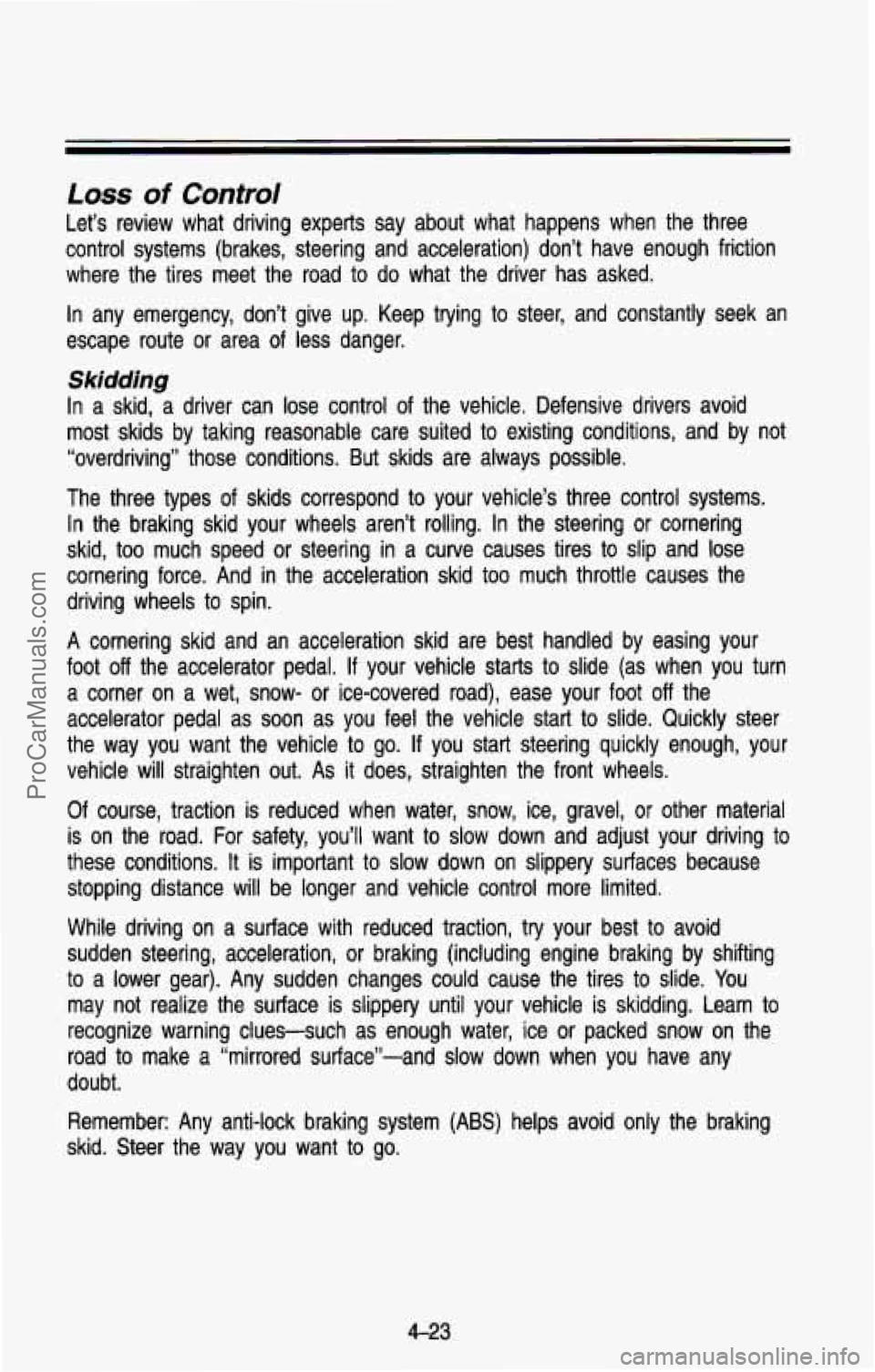
Loss of Control
Let’s review what driving experts say about what happens whe\
n the three
control systems (brakes, steering and acceleration) don’t ha\
ve enough friction
where the tires meet the road to do what the driver has asked.
In any emergency, don’t give up. Keep trying
to steer, and constantly seek an
escape route or area of less danger.
Skidding
In a skid, a driver can lose control of the vehicle. Defensive d\
rivers avoid
most skids by taking reasonable care suited
to existing conditions, and by not
“overdriving” those conditions. But skids are always possib\
le.
The three types of skids correspond
to your vehicle’s three control systems.
In the braking skid your wheels aren’t rolling. In the steering
or cornering
skid,
too much speed or steering in a curve causes tires to slip and lose
cornering force. And in the acceleration skid too much throttle causes the
driving wheels to spin.
A cornering skid and an acceleration skid are best handled by easing your
foot off the accelerator pedal. If your vehicle starts to slide (as when you turn
a corner on a wet, snow-
or ice-covered road), ease your foot off the
accelerator pedal as soon as you feel the vehicle start
to slide. Quickly steer
the way you want the vehicle
to go. If you start steering quickly enough, your
vehicle will straighten out. As it does, straighten the front wheels.
Of course, traction is reduced when water, snow, ice, gravel,
or other material
is on the road.
For safety, you’ll want to slow down and adjust your driving to
these conditions.
It is important to slow down on slippery surfaces because
stopping distance will be longer and vehicle control more limit\
ed.
While driving on a surface with reduced traction,
try your best to avoid
sudden steering, acceleration,
or braking (including engine braking by shifting
to a lower gear). Any sudden changes could cause the tires t\
o slide. You
may not realize the surface is slippery until your vehicle is \
skidding. Learn to
recognize warning clues-such as enough water, ice or packed snow on the
road to make a “mirrored surface”-and slow down when you have any\
doubt.
Remember: Any anti-lock braking system (ABS) helps avoid only the braking
skid. Steer the way you want
to go.
4-23
ProCarManuals.com
Page 193 of 386
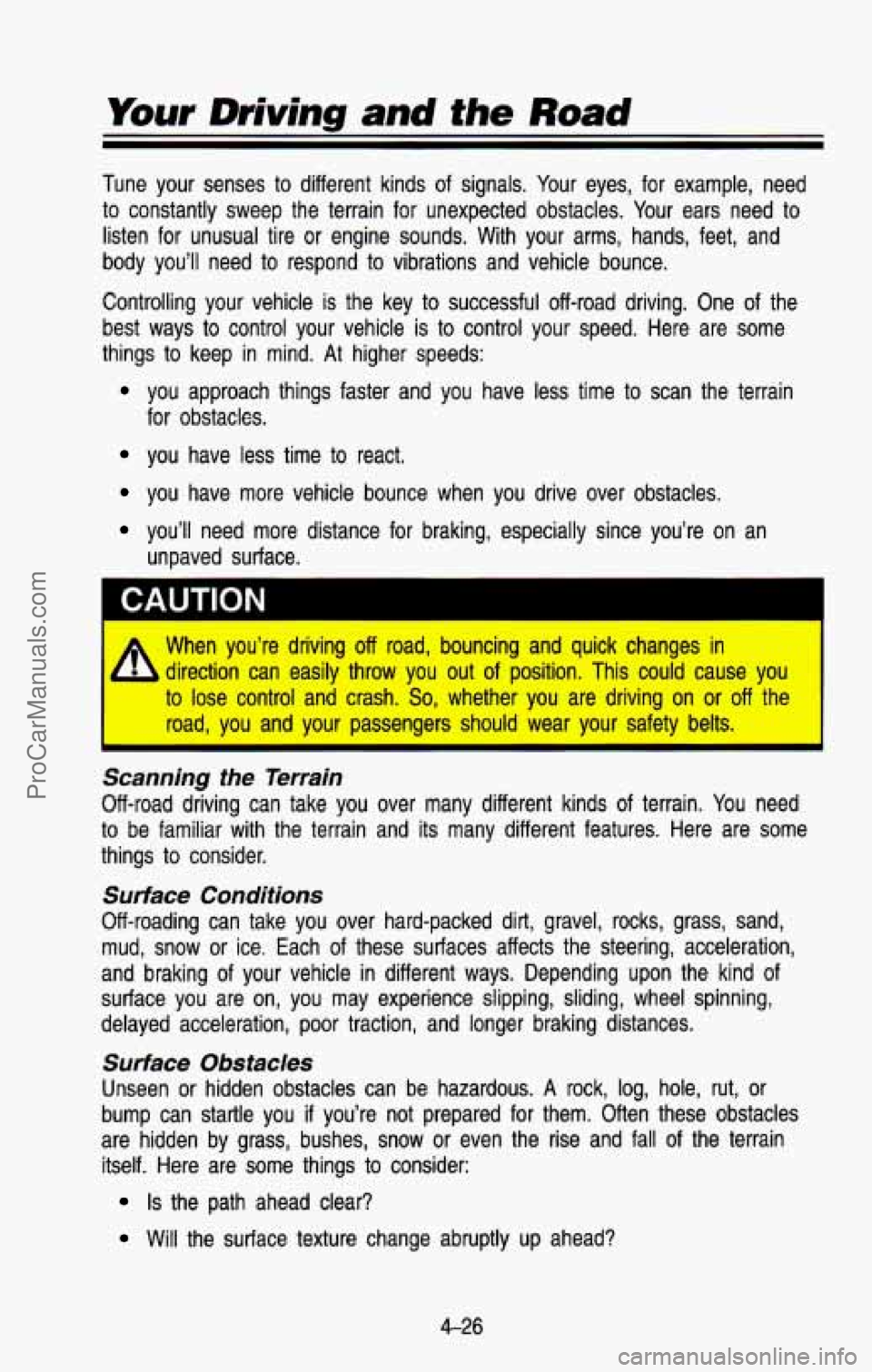
Your Driving and the Road
Tune your senses to different kinds of signals. Your eyes, for example, need
to constantly sweep the terrain for unexpected obstacles. Your ears need to
listen for unusual tire or engine sounds. With your arms, hand\
s, feet, and
body you’ll need to respond
to vibrations and vehicle bounce.
Controlling your vehicle is the key to successful off-road driving. One of the
best ways to control your vehicle
is to control your speed. Here are some
things to keep in mind.
At higher speeds:
you approach things faster and you have less time to scan the\
terrain
for obstacles.
you have less time to react.
you have more vehicle bounce when you drive over obstacles.
you’ll need more distance for braking, especially since you’\
re on an
unpaved surface.
A
When you’re driving off road, bouncing and quick changes in I
direction can easily throw you out of position. This could cause you
to lose control and crash.
So, whether you are driving on or off the
road, you and your passengers should wear your safety belts.
Scanning the Terrain
Off-road driving can take you over many different kinds of terrain. You need
to be familiar with the terrain and its many different features. Here are some
things to consider.
Surface Conditions
Off-roading can take you over hard-packed dirt, gravel, rocks, grass, sand,
mud, snow or ice. Each of these surfaces affects the steering, acceleration,
and braking of your vehicle in different ways. Depending upon the kind of
surface you are on, you may experience slipping, sliding, wheel spinning,
delayed acceleration, poor traction, and longer braking distances\
.
Surface Obstacles
Unseen or hidden obstacles can be hazardous. A rock, log, hole, rut, or
bump can startle you
if you’re not prepared for them. Often these obstacles
are hidden by grass, bushes, snow
or even the rise and fall of the terrain
itself. Here are some things to consider:
Is the path ahead clear?
Will the surface texture change abruptly up ahead?
4-26
ProCarManuals.com
Page 194 of 386

Does the travel take you uphill or downhill? (There’s more discussion of
these subjects later.)
Will you have to stop suddenly or change direction quickly?
When you drive over obstacles
or rough terrain, keep a firm grip on the
steering wheel. Ruts, troughs, or other surface features can jerk the wheel
out of your hands
if you’re not prepared.
When you drive over bumps, rocks, or other obstacles, your wheels can leave
the ground.
If this happens, even with one or two wheels, you can’t control
the vehicle as well or at all.
Because you will
be on an unpaved surface, it’s especially important to avoid
sudden acceleration, sudden turns, or sudden braking.
In a way, off-road driving requires a different kind of alertness from driving on
paved roads and highways. There are no road signs, posted spee\
d limits or
signal lights. You have to use your
own good judgment about what is safe
and what isn’t.
I CAUTION
Drinking and driving can be very dangerous on any road. And this is
- b certainly true for off-road driving. At the very time you need special
alertness and driving skills, your reflexes, perceptions and jud\
gment
can be affected by even a small amount
of alcohol. You could have
a serious-or even fatal-accident
if you drink and drive or ride with
a driver who has been drinking. (See “Drunken Driving” in the
Index.)
Driving On Oft-Road Hills
Off-road driving often takes you up, down, or across a hill. Driving safely on
hills requires good judgment and an understanding of what your vehicle can
and can’t do. There are some hills that simply can’t be driven, no matter how
well-built the vehicle.
I CAUTION
A Many hills are simply too steep for any vehicle. If you drive up them,
62 you will stall. If you drive down them, you can’t control your speed. If
you drive across them, you will roll over. You could be seriously
injured or killed.
If you have any doubt about the steepness, don’t
drive the hill.
4-27
ProCarManuals.com
Page 195 of 386
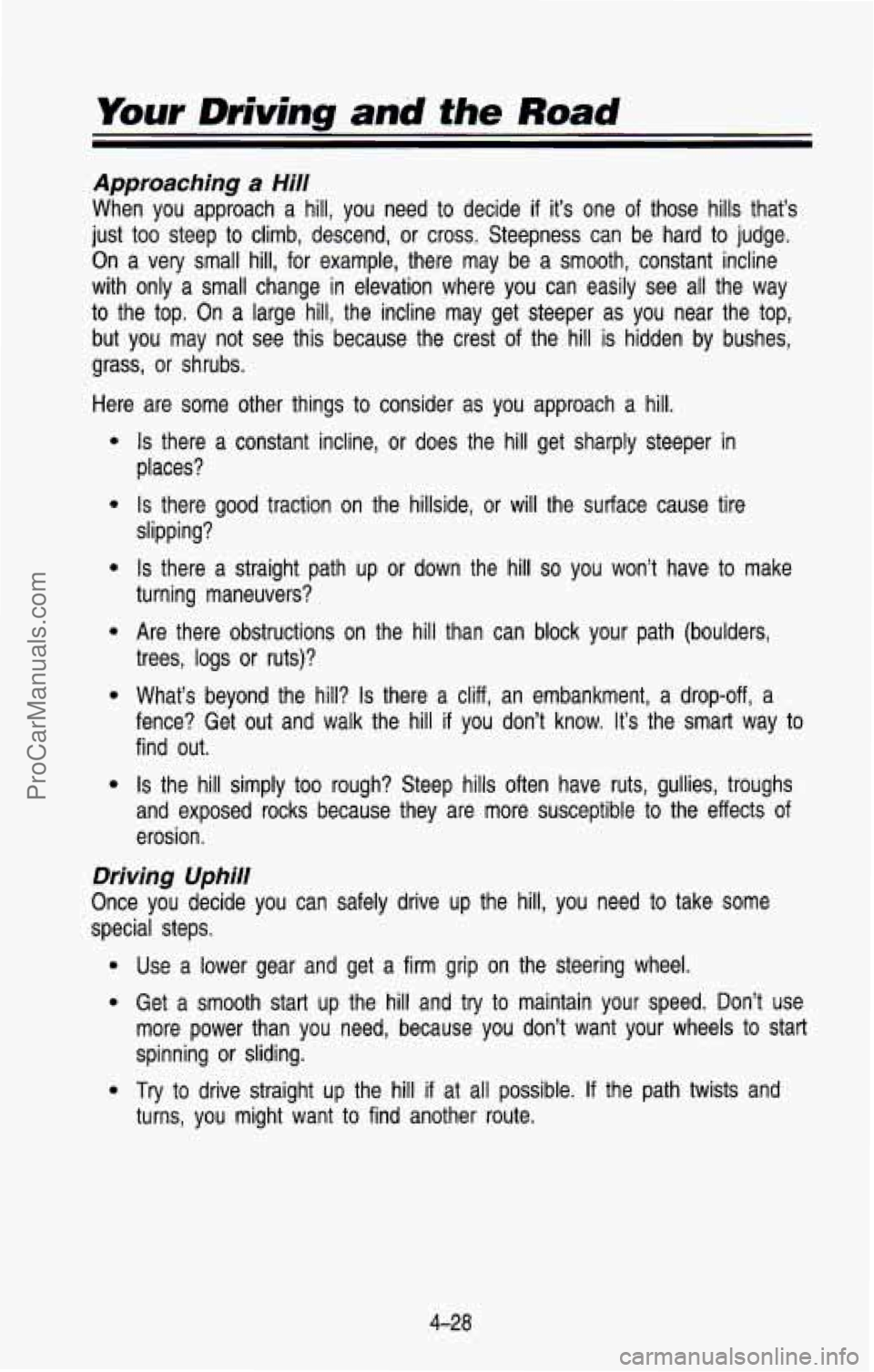
Your Driving and the Road
Approaching a Hill
When you approach a hill, you need to decide if it’s one of those hills that’s
just too steep to climb, descend, or cross. Steepness can be hard to judge.
On a very small hill, for example, there may be a smooth, constant incline
with only a small change in elevation where you can easily se\
e all the way
to the top. On a large hill, the incline may get steeper as you near the top,
but you may not see this because the crest of the hill is hidden by bushes,
grass, or shrubs.
Here are some other things to consider as you approach a
hill.
e
e
e
e
e
0
Is there a constant incline, or does the hill get sharply steeper\
in
places?
Is there good traction on the hillside, or will the surface cause tire
slipping?
Is there a straight path up
or down the hill so you won’t have to make
turning maneuvers?
Are there obstructions
on the hill than can block your path (boulders,
trees, logs or ruts)?
What’s beyond the hill? Is there a cliff, an embankment, a drop-off, a
fence? Get out and walk the hill
if you don’t know. It’s the smart way to
find out.
Is the hill simply too rough? Steep hills often have ruts, gu\
llies, troughs
and exposed rocks because they are more susceptible to the eff\
ects of
erosion.
Driving Uphill
Once you decide you can safely drive up the hill, you need to take some
special steps.
e
e
e
Use a lower gear and get a firm grip on the steering wheel. \
Get a smooth start up the hill and try to maintain your speed. Don’t use
more power than you need, because you don’t want your wheel\
s to start
spinning or sliding.
Try to drive straight up the hill if at all possible. If the path twists and
turns, you might want to find another route.
4-28
ProCarManuals.com
Page 200 of 386
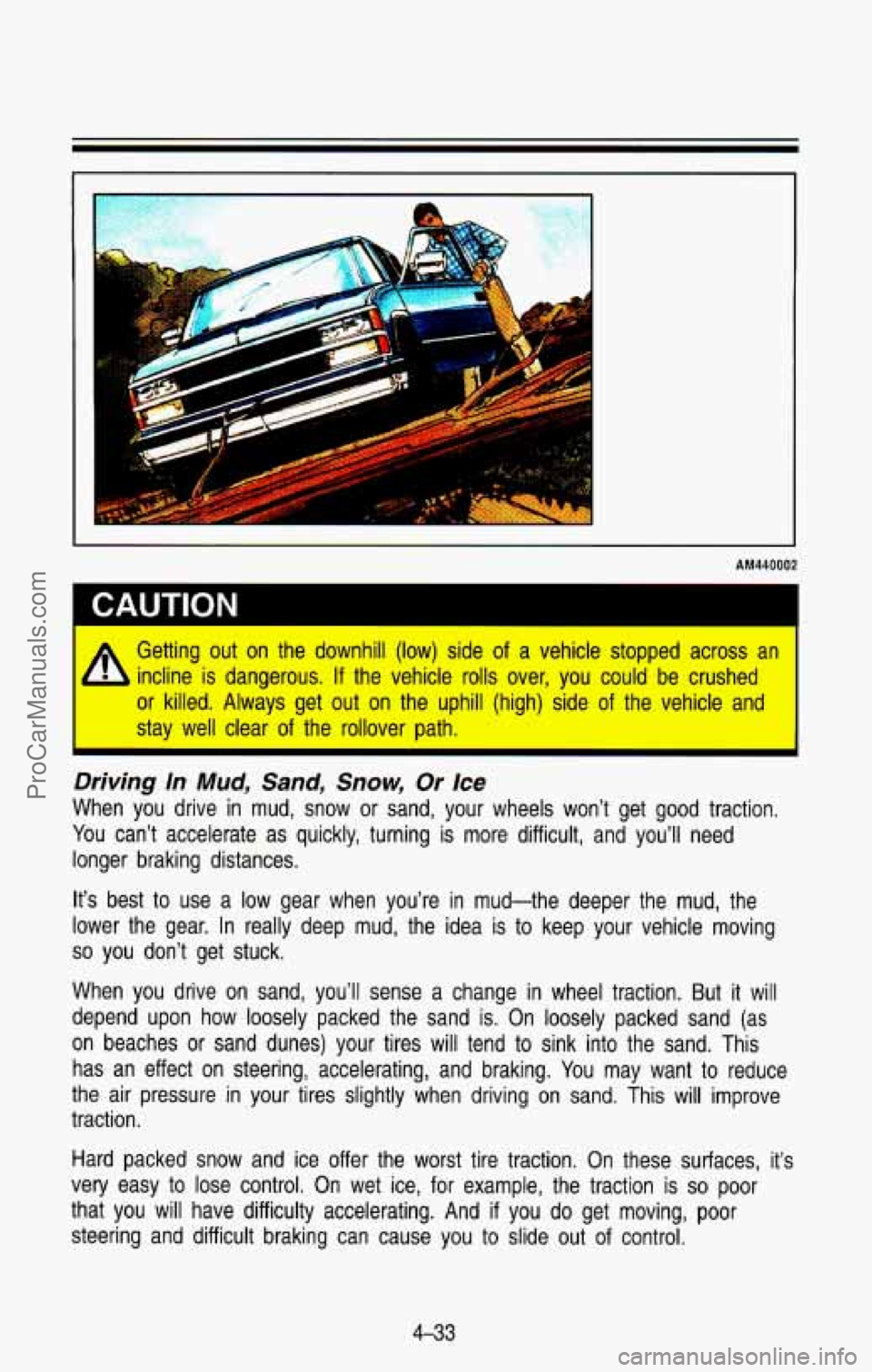
AM440002
I Getting out on the downhill (low) side of a vehicle stopped across an
- , incline is dangerous. If the vehicle rolls over, you could be crushed
or killed. Always get out on the uphill (high) side of the vehicle and
stay well clear of the rollover path. F
Driving In Mud, Sand, Snow, Or Ice
When you drive in mud, snow or sand, your wheels won’t get\
good traction.
You can’t accelerate as quickly, turning is more difficult, and \
you’ll need
longer braking distances.
It’s best to use a low gear when you’re in mud-the deeper the \
mud, the
lower the gear. In really deep mud, the idea is
to keep your vehicle moving
so you don’t get stuck.
When you drive on sand, you’ll sense a change in wheel tra\
ction. But
it will
depend upon how loosely packed the sand is. On loosely packed \
sand (as
on beaches or sand dunes) your tires will tend to sink into the\
sand. This
has an effect on steering, accelerating, and braking. You may want to reduce
the air pressure
in your tires slightly when driving on sand. This will improve
traction.
Hard packed snow and ice offer the worst tire traction. On these surfaces, it’s
very easy to lose control. On wet ice, for example, the tract\
ion is
so poor
that you will have difficulty accelerating. And
if you do get moving, poor
steering and difficult braking can cause you to slide out
of control.
4-33
ProCarManuals.com
Page 212 of 386
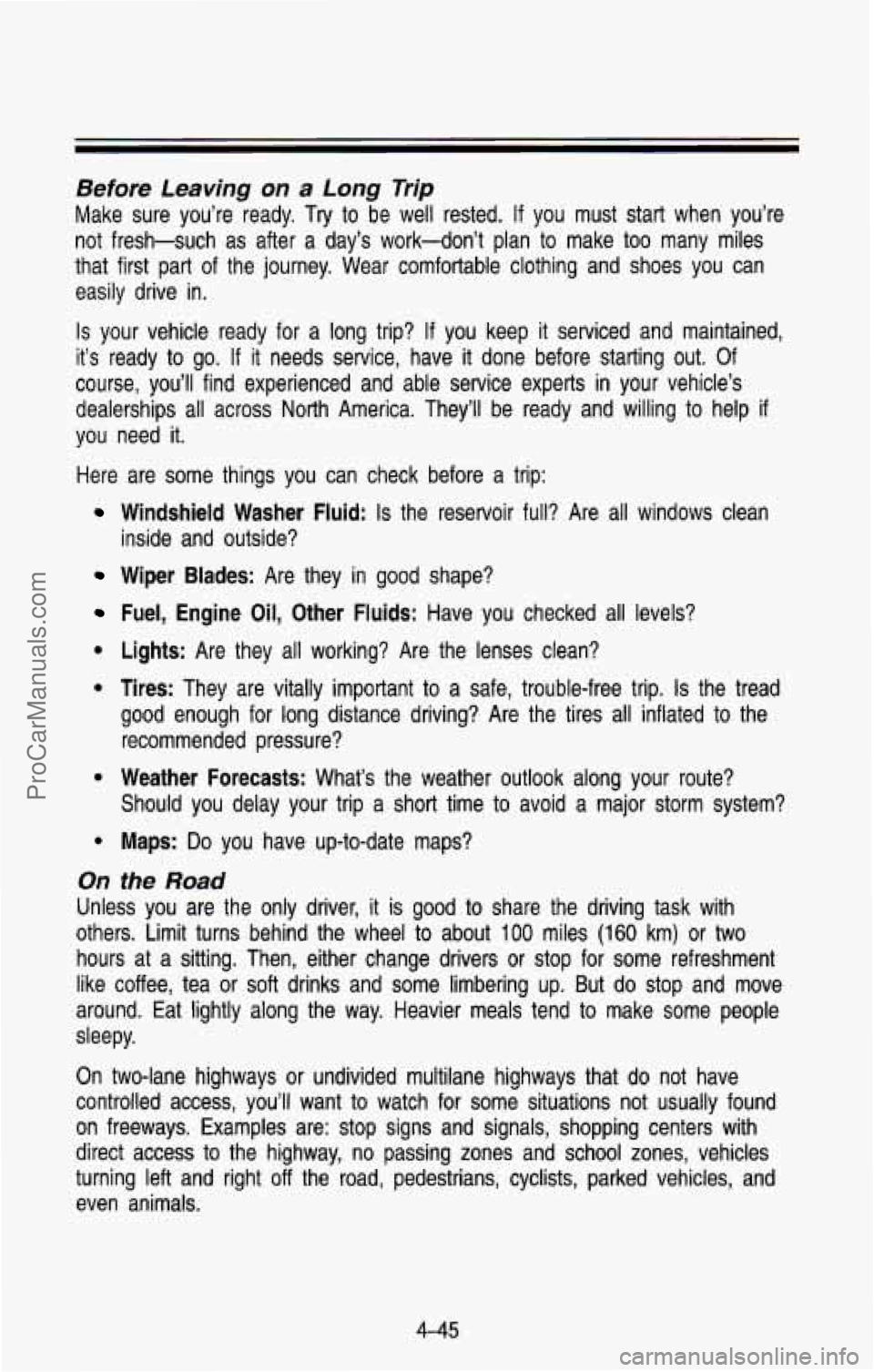
Before Leaving on a Long Trip
Make sure you’re ready. Try to be well rested. If you must start when you’re
not fresh-such as after a day’s work-don’t plan to make too many miles
that first part of the journey. Wear comfortable clothing and shoes you can
easily drive in.
Is your vehicle ready for a long trip? If you keep it serviced and maintained,
it’s ready to go. If it needs service, have it done before starting out. Of
course, you’ll find experienced and able service experts
in your vehicle’s
dealerships all across North America. They’ll be ready and w\
illing to help
if
you need it.
Here are some things you can check before a trip:
e
e
On
Windshield Washer Fluid: Is the reservoir full? Are all windows clean
inside and outside?
Wiper Blades: Are they in good shape?
Fuel, Engine Oil, Other Fluids: Have you checked all levels?
Lights: Are they all working? Are the lenses clean?
Tires: They are vitally important to a safe, trouble-free trip. Is the tread
good enough for long distance driving? Are the tires all inflated to the
recommended pressure?
Weather Forecasts: What’s the weather outlook along your route?
Should you delay your trip a short time to avoid a major storm system?
Maps: Do you have up-to-date maps?
the Road
Unless you are the only driver, it is good to share the driving task with
others. Limit turns behind the wheel to about
100 miles (160 km) or two
hours at a sitting. Then, either change drivers or stop for s\
ome refreshment
like coffee, tea or soft drinks and some limbering up. But do stop and move
around. Eat lightly along the way. Heavier meals tend
to make some people
sleepy.
On two-lane highways or undivided multilane highways that do not have
controlled access, you’ll want to watch for some situations not usually found
on freeways. Examples are: stop signs and signals, shopping cen\
ters with
direct access to the highway, no passing zones and school zones, vehicles
turning left and right
off the road, pedestrians, cyclists, parked vehicles, and
even animals.
4-45
ProCarManuals.com
Page 229 of 386
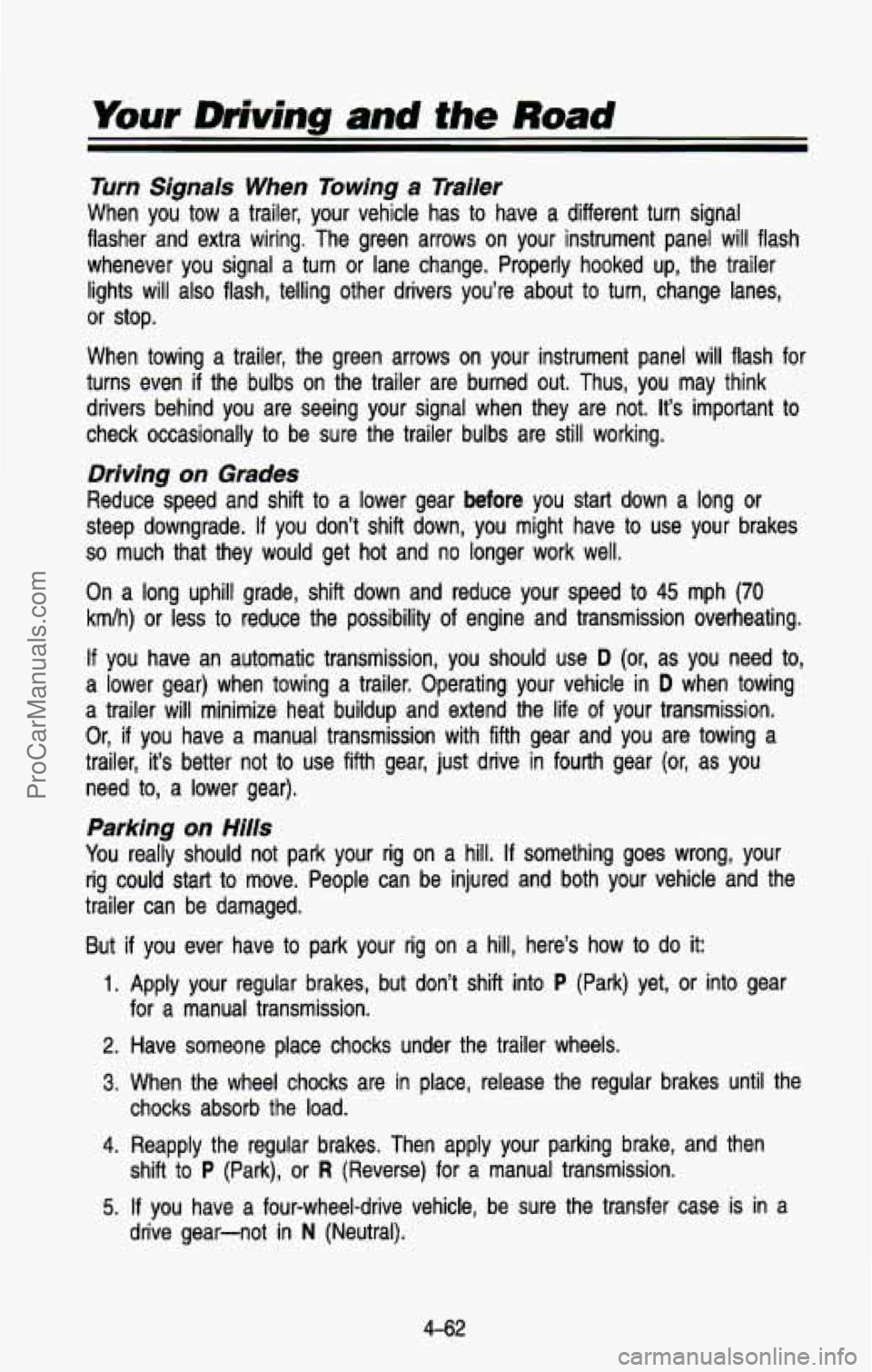
Your Driving and the Road
Turn Signals When Towing a Trailer
When you tow a trailer, your vehicle has to have a different turn signal
flasher and extra wiring. The green arrows on your instrument \
panel will flash
whenever you signal a turn
or lane change. Properly hooked up, the trailer
lights will also flash, telling other drivers you’re about
to turn, change lanes,
or stop.
When towing a trailer, the green arrows on your instrument pan\
el will flash for
turns even
if the bulbs on the trailer are burned out. Thus, you may think \
drivers behind you are seeing your signal when they are not.
It’s important to
check occasionally to be sure the trailer bulbs are still working.
Driving on Grades
Reduce speed and shift to a lower gear before you start down a long or
steep downgrade. If you don’t shift down, you might have to use your brakes
so much that they would get hot and no longer work well.
On
a long uphill grade, shift down and reduce your speed to 45 mph (70
kmlh) or less to reduce the possibility of engine and transmission overheating.
If you have an automatic transmission, you should use D (or, as you need to,
a lower gear) when towing a trailer. Operating your vehicle in D when towing
a trailer will minimize heat buildup and extend the
life of your transmission.
Or,
if you have a manual transmission with fifth gear and you are to\
wing a
trailer, it’s better not
to use fifth gear, just drive in fourth gear (or, as you
need to, a lower gear).
Parking on Hilk
You really should not park your rig on a hill. If something goes wrong, your
rig could start
to move. People can be injured and both your vehicle and the
trailer can be damaged.
But
if you ever have to park your rig on a hill, here’s how to do it:
1. Apply your regular brakes, but don’t shift into P (Park) yet, or into gear
for a manual transmission.
2. Have someone place chocks under the trailer wheels.
3, When the wheel chocks are in place, release the regular brakes\
until the
4. Reapply the regular brakes. Then apply your parking brake, and \
then
chocks absorb the load.
shift
to P (Park), or R (Reverse) for a manual transmission.
5. If you have a four-wheel-drive vehicle, be sure the transfer case \
is in
a
drive gear-not in
N (Neutral).
4-62
ProCarManuals.com
Page 238 of 386
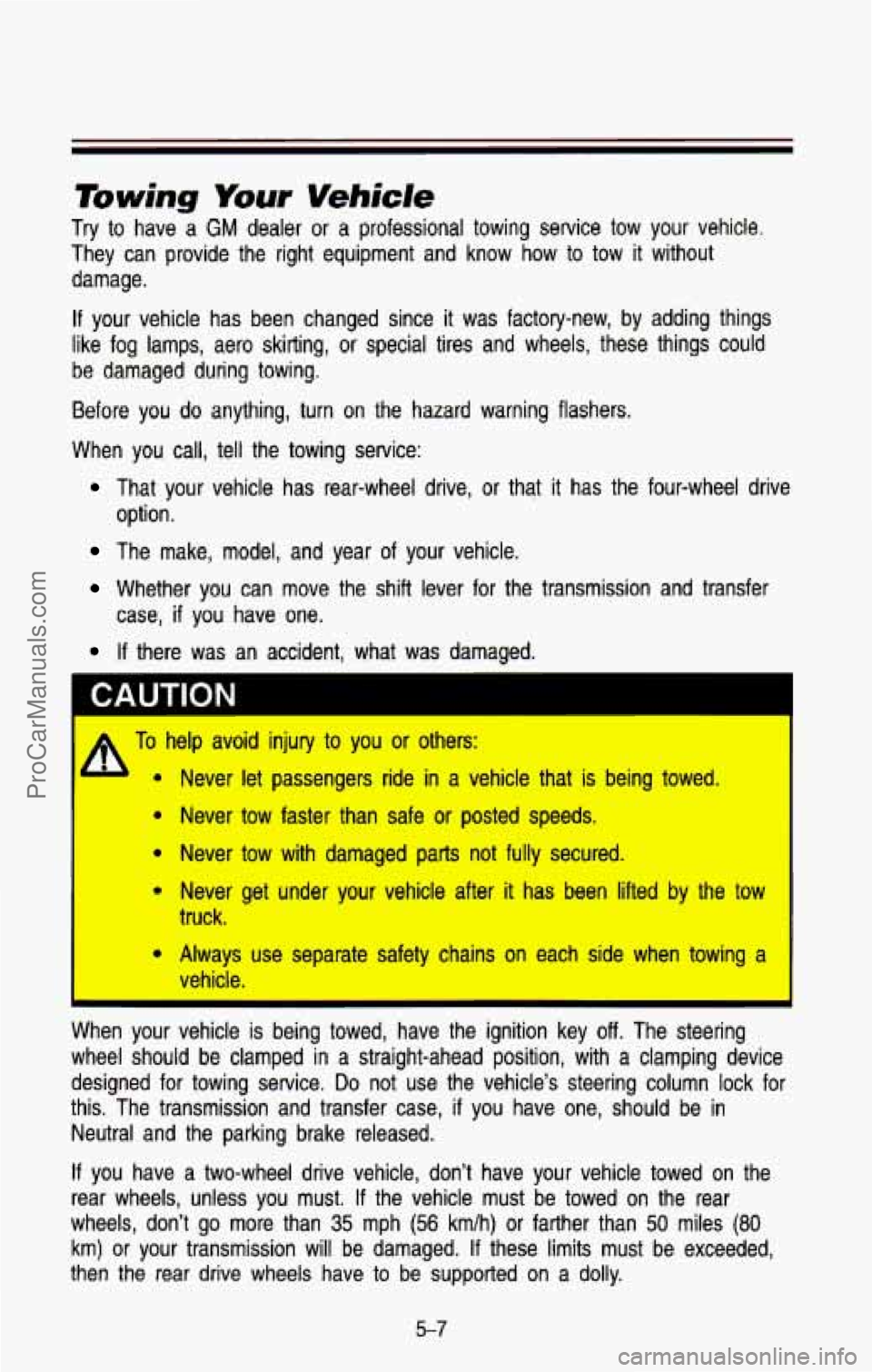
Tiwing Your Vehicle
Try to have a GM dealer or a professional towing service tow your vehicle.
They can provide the right equipment and know how to tow
it without
damage.
If your vehicle has been changed since it was factory-new, by adding things
like fog lamps, aero skirting,
or special tires and wheels, these things could
be damaged during towing.
Before you
do anything, turn on the hazard warning flashers.
When you call, tell the towing service:
That your vehicle has rear-wheel drive, or that it has the four-wheel drive
option.
The make, model, and year of your vehicle.
Whether you can move the shift lever for the transmission and \
transfer
If there was an accident, what was damaged.
case,
if you have one.
CAUTION I
To help avoid
injury to you or others:
A 9 Never let passengers ride in a vehicle that is being towed.
e Never tow faster than safe or posted speeds.
e Never tow with damaged parts not fully secured.
Never get under your vehicle after it has been lifted by the tow
truck.
* Always use separate safety chains on each side when towing a
vehicle.
When your vehicle is being towed, have the ignition key off. The steering
wheel should be clamped in a straight-ahead position, with a clamping device
designed for towing service.
Do not use the vehicle’s steering column lock for
this. The transmission and transfer case,
if you have one, should be in
Neutral and the parking brake released.
If you have a two-wheel drive vehicle, don’t have your vehicle \
towed on the
rear wheels, unless you must.
If the vehicle must be towed on the rear
wheels, don’t
go more than 35 mph (56 kmlh) or farther than 50 miles (80
km) or your transmission will be damaged. If these limits must be exceeded,
then the rear drive wheels have to be supported on a dolly.
5-7
ProCarManuals.com